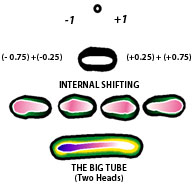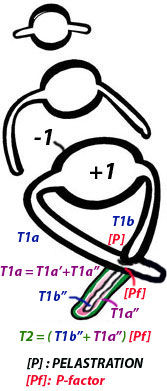|
|||
|
|
| The Beginning of the Universe. This is rather 'special' stuff. The beginning? In most cosmological models space evolves, starting from a point-like entity, around 15 billion years ago and expanding in size. Steven Hawking stated that - under Einsteins conditions of General Relativity - that a configuration of a large mass concentrated in a small volume of space (suggested by the Big Bang models) must have singularity at the beginning, and that means that the Universe had a definite beginning. Hawking said also on Black Holes that the final state of a mass contracting down to inside that Event Horizon is that of a Singularity, of a point with infinite mass concentration and curvature of space, a knot in the fabric of space and time. Interesting. The origin of the gravitation membrane is an absolute gravity field should - in our hypothesis of an unbreakable and infinite elastic membrane (check 'tensegrity of Buckminster') - implicate that gravitons are linked to neighboring gravitons by transversal (90° on the gravitron influencing direction) operating intermediaries. When the membrane curls it curls of course also. The most opportune gravitron structure in a tensegritic membrane is the Buckyball 5-6 binding or triangle shapes which goes over in 'nano-tube'-type tubes (which are hollow) after zillions of pelastrations on the start of the Universe. But ... I am going to keep it simple and start the standard way: Our basic departure point to create the Big Tube: ZERO = (-1) + (0) + (+1).
The multi-dimensional Universe consists of a giant basic (fielded) tube. This Big Tube sub-divides itself by dimensional pelastrations and spacial actions in trillions of more complex sub-tubes. So a number of sub-zones are created by self-pelastrations, pelastrations, coiling, rotation, torque, knotting, tunneling, spiraling, ... provoking new dimensions by subsequential layering extra (dimensional) membrane skins or by changing internal conditions in the tube-zones involved, but de-creates also sub-tubes in opposite ways. Since all membrane-zones are part of the same T1 membrane any movement in one of the tube-zones will influence someway all other zones. We call this process: "Tunity'.
Sub-Tubes inside a Tube Zone. A Ty may encounter a Tx of such density that he splits in a number of smaller sub-tubes (Ty1, Ty2 ... Tyn) from which some may stay inside the Tx tube-zone, interacting with or influencing the internal fields. These sub-tubes may coil, pelastrate, push-a-side, bend, strangle, rotate, split, etc. each-other just like the large tubes can do. And also micro-tubes of other dimensions (tube-zones) may interact - under certain conditions - with them. And in each of those tiny sub-tunes T1 is still the center. ;-) A remark: Some people like Buckminster (him again) start(ed) in their cosmological view from specific balanced shapes, like a Duo-Tetrahedron in a vector equilibrium net. Our tubes can start on the vortex (center of the side, on the vertex - corners - the field is repulsive), going outside and/or inside, and come to identical pelastration actions. Pelastration is then more 'angle' bounded. This is here however not a point of discussion. |
||||||||||||
|
© Dirk Laureyssens, 2002. All rights reserved.
|







